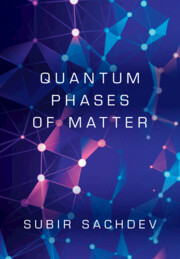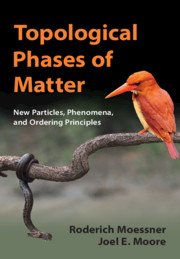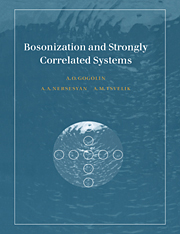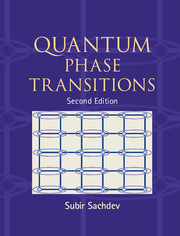Quantum Phases of Matter
This modern text describes the remarkable developments in quantum condensed matter physics following the experimental discoveries of quantum Hall effects and high temperature superconductivity in the 1980s. After a review of the phases of matter amenable to an independent particle description, entangled phases of matter are described in an accessible and unified manner. The concepts of fractionalization and emergent gauge fields are introduced using the simplest resonating valence bond insulator with an energy gap, the Z2 spin liquid. Concepts in band topology and the parton method are then combined to obtain a large variety of experimentally relevant gapped states. Correlated metallic states are described, beginning with a discussion of the Kondo effect on magnetic impurities in metals. Metals without quasiparticle excitations are introduced using the Sachdev-Ye-Kitaev model, followed by a discussion of critical Fermi surfaces and strange metals. Numerous end-of-chapter problems expand readers' comprehension and reinforce key concepts.
- Suitable for self-study, the book begins with basic many-body theory and builds up the formalism of fractionalization and emergent gauge fields in a systematic manner
- Begins with a survey of experiments, and maintains a strong connection between theory and observations, making the text valuable to experimentalists
- Includes numerous end-of-chapter problems, allowing the reader to further develop their understanding of key concepts
Reviews & endorsements
'A visionary, provocative, and thoughtful text: Sachdev's narrative ties his intellectual motivation to a set of striking emergent phenomena observed in experiments on well-characterized quantum materials and devices. It explores modern topics from a systematic and unified perspective based on effective field theories. The derivations give plenty of intuitive guidance to make the physical meaning of each transformation transparent for student or expert. The author covers a broad swath of the intellectual framework that underlies many of the most interesting contemporary developments in condensed matter theory.' Steven Kivelson, Stanford University
'Quantum Phases of Matter is a rich topic with important experimental and even technological implications. Subir Sachdev is one of the leading researchers in this field. His book gives a self-contained, pedagogical exposition of many of the exciting developments in that area. Sachdev's unmatched deep insight, his comprehensive understanding of the subject, and his clear presentation skills make this book a must-read textbook for students and an extremely useful reference for researchers.' Nathan Seiberg, Institute for Advanced Study, Princeton
'Quantum Phases of Matter is a must-read magnum opus from the leading expert, revealing his deep insights and wonderfully complementing Quantum Phase Transitions, which has been the best reference on the subject since publication. This new book skilfully takes the reader on an exhilarating, yet pedagogical tour of quantum condensed matter, from the basic to the most advanced frontier topics of current research. Theorists - from students to faculty - will be eager to dig into this masterpiece, to learn the secrets of the trade from its master.' Leo Radzihovsky, University of Colorado, Boulder
Product details
March 2023Adobe eBook Reader
9781009212687
0 pages
This ISBN is for an eBook version which is distributed on our behalf by a third party.
Table of Contents
- Preface
- 1. Survey of experiments
- Part I: Background:
- 2. Fermi liquid theory
- 3. Dilute Bose gas
- 4. BCS theory of superconductivity
- 5. Broken symmetry and superfluidity
- 6. Landau–Ginzburg theory
- 7. Vortices in superfluids
- 8. Boson Hubbard model
- 9. Electron Hubbard model
- 10. Relativistic scalar field: diagrams
- 11. Relativistic scalar field: correlation functions
- 12. Fermions and bosons
- Part II. Fractionalization and Emergent Gauge Fields I:
- 13. Introduction to gapped spin liquids
- 14. Fractionalization in the XY model in 2+1 dimensions
- 15. Theory of gapped Z2 spin liquids
- 16. Z2 gauge theory
- 17. Chern–Simons gauge theories
- Part III. Band Topology:
- 18. Berry phases and Chern numbers
- 19. Integer quantum Hall states
- 20. Topological insulators and superconductors
- Part IV. Fractionalization and Emergent Gauge Fields II:
- 21. Parton theories
- 22. The chiral spin liquid
- 23. Non-Abelian Ising anyons
- 24. Fractional quantum hall states
- 25. Dualities of XY models and U(1) gauge theories
- 26. Applications of dualities to spin liquids
- 27. Boson–fermion and fermion–fermion dualities
- 28. Gapless spin liquids
- Part V. Correlated Metals:
- 29. Kondo impurity model
- 30. The heavy Fermi liquid
- 31. The fractionalized Fermi liquid
- 32. SYK models
- 33. Random quantum spin liquids and spin glasses
- 34. Fermi surfaces without quasiparticles
- Appendix A. coherent state path integral
- Appendix B. Grassman path integral
- Appendix C. From spin Berry phases to background gauge charges
- Appendix D. Emergent Z2 gauge theories
- References
- Index.





